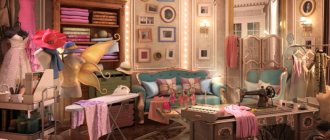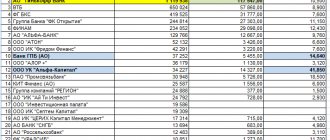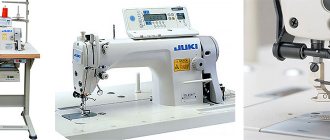We open a showroom from scratch and start making money
Secrets of discovery: paperwork, rent, selection of suppliers, algorithm of actions.
Article navigation
- What is a women's clothing showroom?
- Assessing prospects before opening
- Advantages and disadvantages
- How much does it cost to open your own showroom with clothes?
- Initial Investment
- Monthly expenses
- Business registration procedure
- Selecting OKVED and tax system
- Getting permission to open
- Other features of the legal side
- What documents are needed to open a showroom?
- How to open your showroom from scratch: algorithm of actions
- Payback and profitability of a clothing showroom
- Drawing up a business plan for opening a showroom
- Selection of premises and equipment for the showroom
- What, how and where to sell: choosing a direction
- Where to buy products and how to find suppliers
- Variety of assortment
- How to display goods correctly
- Recruitment of personnel for the showroom
- How to open your own clothing showroom on Instagram
- Advertising as an engine of trade
- Promoting the showroom before its opening
- Promotion means
- Accounting and record keeping
- How much can you earn
- Features of such a business
- What problems may arise
- Showroom franchises
- conclusions
A showroom is a fashion store, but more like a showroom. Here you can get acquainted with the new collections of a certain manufacturer or designer and place an order. Organizing such a store can become a profitable business. The main components of success are a clear understanding of what is needed to open a showroom and a competent assessment of possible risks.
Relevance of this business
Show room has several definitions:
- a room in which works of unique pieces from novice designers are presented;
- a place where items of different styles are shown to wholesale customers;
- atelier of an unfamiliar designer with high-quality models of unique wardrobe items (tailoring of an individual order is provided).
Western countries define Show Room differently - a room for communication between designers and implementation managers.
No deals. Opening a clothing showroom brings high, stable income. The demand for a specific product category is constantly growing. According to the previous year's indicators, consumers prefer to make purchases by trying on goods. Online stores represent worthy competition. The number of sales is growing. However, most people prefer to make a purchase by trying the item on first. The show room provides such pleasure.
Many people start their own business, but not everyone manages to gain a foothold. The average spend of buyers is 15,000-30,000 thousand on outfits and accessories. The flow of buyers is inexhaustible.
In order for profitability to maintain stability, it is necessary to correctly draw up a business project.
What is a women's clothing showroom?
Showroom is a word borrowed from English and means “showroom” in translation. Initially, such stores were created for wholesale buyers - buyers who ordered wholesale quantities of goods for their outlet. Now showrooms have become available to the average consumer. They display clothing collections and sell existing items. In many establishments, the client will undertake to sew the model he likes.
Delivery of clothes to showrooms is carried out on a pre-order basis, so their range is small. The advantage is that the buyer has the opportunity to purchase a branded item of excellent quality and unique design on very favorable terms.
For young designers, this business provides an excellent chance to find their consumer.
Showrooms, depending on the method of organization, are divided into:
- small studio shops that sell products from one manufacturer;
- fashion salons or studios for demonstrating new clothing collections from groups of designers;
- showrooms with a podium at fashion stores or clothing factories.
Today, many people buy clothes online. But there are buyers for whom it is important to try on a dress or suit they like and see it with their own eyes. Therefore, online stores began to open their showrooms. Here the client has the opportunity to evaluate the quality of the fabric and tailoring of the model selected from photographs and descriptions on the website. But ordering goods is carried out only online.
Where to buy clothes
Product exclusivity is one of the main characteristics of a showroom. Visitors will not be interested in clothing, which is available in abundance in regular stores. Therefore, it is useless for a beginner to contact ordinary suppliers. However, acquiring unique collections is not easy: they become freely available when they move into the category of mass fashion. There are a number of ways to provide yourself with goods:
- Outlets. These are supermarkets where factories sell the remnants of last year's and new collections. Discounts reach 70%, but there are few popular sizes on display.
- Factories. They sell small wholesale clothes directly from the workshop, without retail markups. Available in any sizes and colors.
- Chinese manufacturers. You can buy goods from China on sites like AliExpress cheaply, but the quality is a lottery.
- Wholesale bases. In Europe there are warehouses where they purchase clothing in bulk in an assortment. But they will not be interested in an order of 5,000 euros.
- Beginner designers. Find a talented unrecognized craftsman and get the right to sell his products.
- Private studios. Domestic fashion designers sew clothes no worse than famous brands. And they will not refuse to make changes at the request of the buyer.
When planning to open a showroom, choose suppliers carefully: delays or defects in a batch inevitably result in losses. Therefore, take into account sellers’ prices and factors such as:
- Delivery terms. It’s bad when a factory works with expensive courier services or offers only pickup.
- Return Policy. We are talking about obvious defects and the possibility of sending back unsold products.
- Availability of bonuses. Find out if the supplier has cumulative discounts and whether you need to buy a certain amount of goods monthly.
- Sales scheme. Sometimes they are faced with a limit on the minimum amount of a one-time purchase or the need to order the entire size range.
- Shipment rules. Find out whether there is a need to reserve the goods or make a partial or full prepayment.
- Relevance of information. It is important for the showroom owner that the supplier regularly provides data on warehouse balances.
- Availability of escort. Selling clothes is easier when the factory sends photos and descriptions of the models, and quality certificates for them.
To launch a showroom, it is not enough to find a supplier of goods; these clothes must be imported to Russia. The problem is that without paying a duty, a citizen has the right to purchase products worth 500 euros per month abroad. Solution: cut off the tags from the items and indicate in the declaration that these are “samples not for sale . Without risk and doing everything according to the rules, you will have to give the state up to 30% of the cost of the goods, including 20% VAT.
Assessing prospects before opening
For a person who understands fashion and knows how to put together stylish sets, opening a showroom with clothes from scratch will not be difficult. But it will not be possible to get a large influx of customers immediately after organizing a business, since it will take some time to form a pool of buyers. Before starting your business, it is recommended to conduct a thorough analysis of the chances of possible promotion of your store:
- Purchasing power. The future owner of a showroom must analyze who his buyer will be and what part of his income he is willing to spend on updating his own wardrobe.
- Product sales market. An entrepreneur needs to analyze whether there will be enough consumers for his products and how long he can retain them. You should also decide on the orientation of the store and the age category of customers.
- Cost of consumables. If you open a clothing showroom, the business will be to promote it. Therefore, it is necessary to carefully research what can be purchased and what can be sewn for the purpose of further sale. You will also have to spend money on decorating the room, purchasing mannequins, hangers, mirrors, chairs and other interior elements.
Organizing a showroom requires considerable knowledge and effort. Success from the start is possible provided that you are well prepared for the task. If an entrepreneur is going to sell clothes to retail customers, he must understand that they are looking for exclusive models. Therefore, he will have to enter into contracts with domestic designers or organize delivery of goods from abroad.
Opening a successful showroom is impossible without:
- starting capital;
- convenient premises with an advantageous location;
- extensive connections in the fashion world.
Many entrepreneurs are planning to open a showroom at home. This allows you to significantly save on the purchase or rental of retail space. In the absence of start-up capital, you can organize a franchise business. In this case, an agreement is concluded with the supplier company, the obligatory condition of which is the deduction of part of the profit from sales to this company.
An entrepreneur planning to create such a project must be well versed in the world of fashion, have excellent taste and many acquaintances who have the ability and desire to purchase exclusive items.
Advantages and disadvantages
Opening a showroom allows you to get the following advantages:
- Increasing demand for supply. Fans of a certain brand or style will visit the store more often to purchase the necessary items.
- Advertising for an unknown brand or a young designer. The answer for beginners: where to start? – will be the promotion of products of little-known fashion designers who are just starting their careers, who want to advertise their work, who are ready to sell collections at low prices with good quality materials and tailoring.
- Individual approach to clients. A showroom is not just a store where customers get acquainted with fashion collections, but also a warm, friendly atmosphere, where the client will be advised on the most profitable purchase option and offered coffee or tea.
- Sale of goods at tax-free value.
Of course, every business comes with risk. The showroom is no exception. When opening it, there are possible negative aspects such as:
- small passability of the point;
- long delivery of goods;
- unpopular clothing models;
- incorrect setting of prices for things;
- long-term payback on expensive investments.
How much does it cost to open your own showroom with clothes?
When organizing a business you must:
- choose a room;
- renovate it and create a spectacular interior;
- select personnel;
- decide on suppliers;
- develop an advertising strategy.
The implementation of these activities is impossible without certain investments. Experts have calculated that to open a showroom you will need to spend at least 500 thousand rubles. If you plan to trade fashionable and expensive clothes, the costs will be much higher.
Initial Investment
Average costs for opening a showroom:
| Name of expense item | Amount in rubles |
| State registration and legalization of business | 10 000 |
| Renting premises | 40 000 |
| Repair of the premises (the amount of costs depends on the condition of the rented area) | 300 000 |
| Purchasing furniture | 100 000 |
| Purchase of equipment | 200 000 |
| Purchase of the first batch of goods | 300 000 |
| Payment of taxes | 35 000 |
| Software | 30 000 |
| Creating a personal website | 30 000 |
| Advertising expenses | 30 000 |
| Total: | RUB 1,075,000 |
The total amount depends on the size of the business. It can be reduced if everything is calculated correctly, taking into account reasonable savings. Return on investment can be achieved in 5-8 months if you widely advertise your establishment and encourage regular customers.
Monthly expenses
Monthly expenses include employee salaries, premises rental, taxes, advertising and delivery of goods. If independent purchases are planned, then the costs of transport and hotel accommodation will be added. On average, you will have to invest a tidy sum into the business every month.
Necessary equipment, choice of material
You need to have special equipment and materials to enable the organization to operate:
| Personal Computer | 35,000 rubles |
| Cash register | 8,500 rubles |
| Alarm system | 40,000 rubles |
| Title sign | 20,000 rubles |
| Mannequins | 50,000 rubles |
| Shelving | 20,000 rubles |
| Sofas | 30,000 rubles |
| Showcases | 25,000 rubles |
| Mirrors | 35,000 rubles |
| Tax costs | 35,000 rubles |
| Purchase of goods | 500,000 rubles |
Products can be found cheaper: the Chinese market, ordering models via the Internet. Then the expenses will amount to 500,000 thousand. Prices there are very low.
The amounts are inaccurate, based on an area of 80 square meters. You can refurbish a room at home, then you won’t have to pay rent. The cost of renting 70-90 square meters reaches 90,000 thousand.
More often, those who open a show room convert one room from their living space. It's profitable.
If you act as a creator of outfits, you will equip an atelier at home. If you have an assistant, you need to take into account his salary: 25,000-30,000 thousand.
Decide on the interior style of the show room. All items must be in harmony with each other. Modern trends look beautiful. But the “Retro” style finds its connoisseurs; this year’s fashion trends indicate that the 80s are coming back. It is possible to combine these 2 facts, creating a unique design.
When carrying out cosmetic repairs, choose light colors for the walls. There must be excellent lighting. It is necessary to install many light bulbs and lamps. To make your visitors feel comfortable, buy a soft sofa. Help people experience relaxation and positive emotions.
Place the mirrors in this way: the visitor has access to 100 percent viewing of his figure.
Business registration procedure
The showroom is not considered a store. Therefore, you can take advantage of the tax break to first get up to speed and take a closer look at everything. But if the business is successful, it will have to expand its staff and retail space. This means that the showroom will need to be registered as an individual entrepreneur or LLC.
If the owner plans to sell things at retail, then an individual entrepreneur will be enough. To engage in wholesale trade, it is better to register a limited liability company. The type of accounting will also depend on this. Registration of an individual entrepreneur is much simpler and cheaper, but the entrepreneur is responsible for running the business with all his property.
Creating an LLC requires a lot of money. The company must have an authorized capital (minimum 10 thousand rubles). But the liability of the LLC owner is determined only by those funds of the authorized capital.
Business registration consists of several stages:
- selection of OKVED codes;
- collection of documents;
- filing an application with the tax office.
Selecting OKVED and tax system
When preparing documents for registration of an economic entity, you will need to select an OKVED code. It must be specified for each selected direction. There can be an unlimited number of them and this does not contradict the law.
OKVED codes for retail trade of clothing in specialized stores:
- male and female – 47.71.1;
- fur products - 47.71.3;
- leather – 47.71.4;
- sports – 47.71.5.
The choice of taxation system depends on the performance of the showroom. This may be a simplified option when an income tax of 6% or UTII is paid. The latter method is increasingly popular because it makes it possible to work without a cash register.
Getting permission to open
The territorial tax office issues a trade permit after the entrepreneur registers.
Other features of the legal side
When you plan to sell samples in a showroom, you will need to issue product quality certificates confirmed by state standards. If goods are purchased abroad, then you cannot do without customs declarations.
Registration and registration of business (required documents)
To open an individual entrepreneur you will need about 5,000 rubles. This price includes:
- payment of state duty - 800 rubles;
- opening a current account for non-cash payment – from 0 to 3000 thousand;
- creation of a seal - from 500 to 1500 rubles.
You can transfer control of opening an individual entrepreneur to specialized companies; their services cost up to 5,000 thousand.
Documents required for legalization of individual entrepreneurs:
- photocopy of the passport and all its pages;
- copy of TIN;
- application for registration in form P21001;
- receipt of payment of 800 rubles of state duty;
- when switching to the simplified tax system, an application in form No. 26.2-1 in two copies.
You will need to know your OKVED code. Suggested code for your retail:
- women's, men's and children's clothing - 52.42.1;
- underwear – 52.42.2;
- fur work - 52.42.3;
- leather clothes - 52.42.4;
- sportswear – 52.42.5;
- hosiery - 52.42.6;
- headwear 52.42.7;
- accessory group of clothing (belts, scarves, ties, gloves) – 52.42.8;
- footwear and leather goods – 52.43;
- shoes – 52.43.1;
- leather goods and travel accessories – 52.43.2;
Enter codes that reflect your type of activity. They are presented partially, additional codes may be needed.
Make a choice: simplified tax system or UTII.
The simplified tax system is a taxation option, with a choice of interest rate with a coefficient of 6% or 15%. When choosing, pay attention to costs. If their amount is less than revenue, then 6% is suitable; if expenses take up half or more of revenue, it is more profitable to prefer 15%.
You will also need:
- Permission to engage in entrepreneurial activity.
- Conclusion of Rospotrebnadzor, Gospozhnadzor.
- Fixation of cash register in the tax office.
- Rosstat codes.
- Sanitary passport.
- List of products with certification.
What documents are needed to open a showroom?
To register as an individual entrepreneur, you will need to provide:
- application to the Federal Tax Service;
- copy of passport;
- copy of TIN;
- receipt of payment of state duty.
The list of documents for opening an LLC is much wider. It includes:
- application to the Federal Tax Service;
- decision to establish an LLC;
- letter of guarantee from the owner of the legal address;
- a statement indicating the chosen taxation system;
- LLC charter;
- receipt of payment of state duty.
The entrepreneur will have to purchase a cash register and register it. Upon purchase, a contract for servicing the CCA is concluded. To register a device, you must provide the following documents:
- statement;
- technical passport of the cash register;
- applicant's passport and TIN;
- document confirming the purchase of the cash register;
- documents for the premises in which the CCA will be located;
- device maintenance agreement;
- cashier's journal.
How to open your showroom from scratch: algorithm of actions
When deciding how to open a clothing showroom, an entrepreneur must first choose its concept. This could be an atelier, studio or home boutique. In any case, the work is based on the principle: maximum attention to the client. The salon owner must create the most comfortable conditions possible, offering a choice of exclusive models that cannot be found in regular stores.
The organization of the showroom should be carried out taking into account the wishes and preferences of regular customers. Depending on this, the model you like can be purchased immediately or received by pre-order.
The algorithm of actions when opening a showroom consists of the following stages:
- selection of premises;
- interior design;
- purchase of commercial equipment;
- developing an idea for the name of the showroom;
- selection of suppliers and employees;
- creating an advertising strategy.
Payback and profitability of a clothing showroom
In order for the profitability of the showroom to be high, you need to study the market well and attract generous customers. You can evaluate the efficiency of a store using indicators such as the number of customers over a certain period of time, the size of the average check, the cost of a unit of clothing, and turnover per square meter of area. By changing the indicators, you can adjust the pricing policy and assortment.
Statistics show that a showroom can bring in from 200 to 800 thousand rubles monthly. Of course, most of this money will have to be spent on buying new clothing collections, but personal income will also be quite high. Thanks to this income, the business pays for itself in about 8-10 months of work. The most profitable showroom will be in cities with a population of over 700 thousand people.
Drawing up a business plan for opening a showroom
A well-drafted business plan for a clothing showroom with calculations will provide a solid foundation at the start and protect you from unpleasant mistakes. First of all, you need to decide on the assortment, conduct a thorough analysis of potential competitors, and find suppliers.
A standard business plan for opening a clothing showroom looks like this:
- resume of the establishment;
- marketing project;
- production, organizational and financial plans;
- analysis of possible risks.
In the first paragraph, it is necessary to briefly outline the essence of the future project, indicating the amount of investment. The second describes the establishment’s field of activity, conditions for selling products, advertising strategy, etc. The production plan must indicate the location of the showroom, the cost of purchasing equipment, materials, staff salaries and other expenses. The organizational part describes the competitive environment, the category of future buyers, and the scheme for attracting them. The financial section contains information about the budget, taxes, preliminary calculations of profit and payback.
Selection of premises and equipment for the showroom
For a showroom, a room with an area of 50-150 square meters is usually chosen. meters. It must have electric lighting, heating, water supply and air conditioning systems. The best option is to rent premises in a shopping center. This is due, first of all, to high traffic, which can contribute to random purchases, and then to the development of a permanent customer base.
When choosing a showroom location, you should consider:
- traffic, the nature of movement of potential customers;
- income level, age and categories of people living in the selected area;
- availability of similar retail outlets;
- prospects for the development of the area, the possibility of large residential development.
After choosing a room, you can proceed to its arrangement. You will need beautiful and comfortable furniture (sofas, armchairs, coffee tables), display cases, hangers, fitting rooms with mirrors. Trade equipment for a clothing showroom can be purchased or ordered according to your own design.
List of required equipment:
| Equipment | Cost, rub. |
| Reception desk | 40 000 |
| Rack for things | 3 000 |
| Dressing room | 6 000 |
| Mirror | 3 000 |
| Shelves | 6 000 |
| Hangers | 50 |
| Mannequins | 5 000 |
| Sofa | 10 000 |
| Coffee table | 3 000 |
| Cash machine | 10 000 |
| Safe | 10 000 |
| Steamer | 5 000 |
How to design a showroom: choosing a design
The design of the showroom should be stylish and original. You can create an exclusive interior using a variety of lighting, mirrors, draperies, paintings, beautiful flowers in original vases. Walls, floors, curtains and other accessories should match well in color. It should be taken into account that we are setting up a showroom for people who are not poor and have excellent taste. If they don’t like the design, they are unlikely to become regular customers.
A good impression of the studio is created by: calm music, a pleasant smell, cleanliness and order in the room.
What, how and where to sell: choosing a direction
It is important to provide potential buyers with a wide range of truly designer and fashionable items. Such dresses and blouses can make a business successful. The buyer should be able to look, touch and try on any item from the store’s assortment. Therefore, the option of trading with advance payment is not optimal.
Where to buy products and how to find suppliers
Before opening a showroom, find out how to find a supplier of the required product. To order items for the showroom, you must first decide what kind of clothing will be of interest to customers.
When choosing a supplier you should pay attention to:
- delivery conditions (which courier services the supplier cooperates with for the showroom or whether pick-up is offered);
- cost of small and large wholesale;
- Are discounts available for certain models for regular customers?
- Is it possible to return an unsold item?
- Is it possible to take things that are not of the entire size range;
- the ability to use advertising photographs of the manufacturer;
- Payment Methods;
- Availability of quality certificates for purchased items.
Some entrepreneurs prefer to independently purchase goods for the showroom. Those who are well versed in business and brands head to the “world fashion capitals” to order the latest collections. True, such a purchase of clothes is not always possible, since well-known brands do not want to take risks.
Most owners take items for showrooms from the following places:
- Wholesale online stores. Here showrooms order clothes made in China, Thailand, and India.
- Outlets. Typically, last year's collections are offered with large discounts (up to 70%).
- Factories. Here they order clothes for sale in showrooms at cost, which is much cheaper than in outlets and is a more profitable option for businessmen.
- Atelier of little-known designers. You can buy very original and high-quality items from them, which are several times cheaper than similar models created by venerable fashion designers.
Variety of assortment
To ensure that customers do not lose interest in the showroom, the range of products must be updated regularly. When purchasing things, you should focus on fashion trends, since no one wants to wear outdated models. If a store owner does not have a good understanding of what is fashionable, and it is difficult for him to select the assortment on his own, he can find a partner who has studied the nuances of selling clothes. Often the designer himself is invited to this role, especially if he is not yet very famous.
How to display goods correctly
The simplest and most inconspicuous wardrobe items can attract the client’s attention if they are clean, ironed and hanging on hangers in a visible place. The buyer must have good access to any product in order to examine it in detail. Proper display improves sales efficiency and attracts more buyers.
There are certain tricks for arranging goods that make customers want to make a purchase:
- Effective presentation. Shelves, display cases, and mannequins are used. The client must understand how the clothes will look on him, and the three-dimensional representation is very beneficial.
- Displaying a minimum amount of clothing. 2-3 types are enough, if more, the buyer’s attention is scattered.
- A combination of things based on contrasts. This may be the color scheme or models alternate with unpopular products to attract attention.
- Creation of image images. Using mannequins or photos, you can demonstrate a combination of wardrobe elements, complementing them with stylish accessories.
- Discounts. Information about promotions should be placed in a visible place, for example, at the entrance.
Recruitment of personnel for the showroom
The owner of the showroom can work alone, but if there are many clients, then he will have to hire several workers. As a rule, these are 1-2 sellers and an administrator, whose responsibilities include resolving possible controversial issues with buyers, as well as general control over the work of the showroom. Sometimes you also need the help of an accountant.
The sales consultant must know everything about the brands of clothing presented in the showroom, and understand fashion trends, styles, know the rules for combining fabrics and colors, and be able to quickly create an effective image for the client, taking into account the characteristics of his figure.
When choosing personnel, you need to pay attention to such qualities as:
- presentable appearance;
- ability to find a common language with visitors;
- work for efficiency.
How to open your own clothing showroom on Instagram
Opening a clothing showroom on Instagram is quite simple. To do this, you need to link your profile to Facebook, and then come up with an account name, upload a description and photos of the product.
To switch to a business profile, open Instagram, go to settings and click “Switch to business account.” Then, through Facebook, you need to log in to the application and from there synchronize the page with your Instagram account. You should also enter contact information to quickly connect the audience with the store owner.
You can promote your business account on Instagram using paid advertising. At the moment, the cost of the service is relatively low: for just five conventional units you can attract 5 thousand people.
Advertising as an engine of trade
Information about the opening of a store can be conveyed to potential customers in different ways. The simplest and cheapest is word of mouth. But it should be borne in mind that such showroom advertising is ineffective. PR technologies such as:
- creating an emotional, recognizable image of a retail outlet (branding);
- development of a favorable image focused on clientele;
- building relationships with the fashion media;
- promotion of the store on social networks.
Promoting the showroom before its opening
Before the opening, you should make a presentation of the establishment. You can start with a few interested clients, serve them to the highest standard and gain respect. To promote and promote a showroom, you can use social networks on the Internet by creating a store account for this, and also place an ad in a newspaper, public transport, write a note in a magazine, or run a commercial on television.
You should also:
- install a bright sign;
- come up with a memorable logo and apply it to packaging bags;
- order business cards and don’t forget to put them in shopping bags;
- come up with an original motto (slogan) that can be etched in a person’s memory;
- on the opening day, arrange a mini-presentation with the participation of photographers, bloggers and people famous in the fashion world.
Promotion means
When promoting a showroom, an entrepreneur will need to solve the following tasks:
- creating a positive reputation for your establishment;
- distinguishing it from competitors due to the quality and prestige of the product and the provision of additional services;
- informing potential buyers about services and new arrivals of clothing;
- customer feedback support;
- analysis and development of fashion trends.
In order to promote the showroom, you can hold fashion shows every 2-3 months. If your account is successfully promoted, it will be beneficial to post a catalog of items with high-quality photographs and detailed descriptions. The Internet can be used to post announcements with photos, articles about fashion, etc.
Another way to promote is cooperation with bloggers. In exchange for an exclusive interview with the designer, fashion photography with models from the store’s collection, clothing rental, they will make an article or video about the showroom. Information about a store’s reputation, as a rule, spreads quite quickly; after a while, customers themselves begin to advertise it, especially if they are satisfied with the quality of the goods and service.
How to advertise a boutique
Advertising is the basis of any business plan and entrepreneurial venture. Therefore, you should seriously think about it. You can spread the information through your acquaintances and friends. With the help of such word of mouth, it is quite possible to convey information about the existence of the store to your potential customers. The advantage of this method is that it saves money, but this method is not always effective.
Make connections in “elite” and “famous” circles.
You can simply invite representatives to your store by phone. Use social networks on the Internet, create an account for your store. You can write a note in a magazine or newspaper, place advertisements on buses or just on the street.
Try putting a short video about your store on television. The main thing is to try to make the advertisement interesting and attract attention. They often use an original motto that sticks in the memory and helps bring new customers to the store.
If you are a fan of franchises, then most partnership packages include assistance in promoting a store, creating pages on social networks, and their PR on the brand’s “native” resources. The customer coverage in this case is from 50 thousand people. All you need to do is sign an agreement; the franchise owners take care of the rest.
Accounting and record keeping
When opening a store, you not only have to purchase clothes and advertise brands, but also keep accounting records. Registration of commodity transactions is carried out using primary documents - cash receipt, receipt and expenditure invoices. The accounting itself can be cumulative or quantitative-cumulative. In the first case, all sales are displayed in monetary terms, and the second method involves simultaneous accounting, both in monetary units and in quantitative ones.
The main goals of commodity accounting:
- Provide reliable information on the efficiency of using product inventories, revenue volumes, and profit margins. These indicators determine how much income the showroom will receive, how in demand the assortment is, and how quickly product stocks are replenished.
- Monitor the safety of clothing from the moment it arrives at the store until it is sold.
- Identify the main costs and assortment that brings maximum profit, as well as ways to optimize store operations.
Loft
It looks modern, a little rough and brutal, but at the same time, stylish. You can bring the loft style to life in your store by following simple rules:
- Materials. Raw concrete connected with reinforcing ties, rough plaster, facing brick, wood. It would be nice if at least one of the materials is repeated in furniture or accessories. For example, metal mirror frames.
Don’t hide communications, they play one of the key roles in this interior.
- Furniture for goods. Shelves made of pipes will emphasize originality, and exhibition tables and stands made of metal and wood will complete the overall look. Remember that the basis of the loft is free space, so tables can be placed in the middle of the room, but without cluttering it.
For roof rails, you can also use metal pipes without modernization.
The racks don't need to have wheels. With their help, you can easily rearrange furniture, freeing up space as needed.
- Lighting. One of the main points. There should be a lot of light. If there are no windows in the showroom, then it is necessary to think about multi-level lighting using sconces, built-in lighting, retro bases and vintage chandeliers.
Minimalism
One of the most ideal options for a showroom. In the classic design, the color scheme includes the use of white and black, as well as all shades of brown. But lately, designers have been recommending adding single bright accents to a minimalist interior.
An undoubted advantage in this case is cost savings. After all, you don’t have to spend a lot of money on all kinds of details. In addition, clear lines, strict forms and the absence of a large number of pieces of furniture will help maintain order and provide visual freedom.
Ideal if the walls are white. This will not distract customers from the main goal - to purchase things. To attract them to certain areas of the store, you can make bright shelves, or use brightly colored fabric decoration.
If space allows, then it is advisable to allocate a dressing room or pantry for storing things, leaving only the cash register and rails in the hall.
Classic
This style is suitable for showrooms with elegant suits, cocktail and evening dresses. Curls and patterns, characteristic of 19th century interiors, will wonderfully decorate the ceiling and the upper border of the walls, giving the design an aristocratic feel.
It is important to remember that in a classic style the use of bright colors is unacceptable. The color scheme should not distract, but rather set the client up for a detailed study of the product.
A combination of gray and white, blue-green, and muted blue will look harmonious. You can dilute them with gold and bronze.
The ideal finish for the floor is parquet.
As for furniture, you should definitely buy a soft, comfortable sofa for trying on shoes with light upholstery. The set will be complemented by small soft poufs or banquettes.
If this is a clothing store, then a comfortable chair can be located in the fitting room.
Details such as paintings, antique clocks, vases, figurines placed on shelves and behind the cash register counter will complete the look.
Eco
Recently trending, eco-style can be increasingly seen in the design of boutiques. This decision is completely justified, because the eco-interior looks very fresh and spacious.
Moreover, in it, as in minimalism, there is nothing superfluous. Wicker baskets can easily accommodate accessories or small items of clothing.
“Live” greenery will help give the room coziness. A special feature will be the vertical landscaping of the walls.
The interior of the showroom in this style is designed to relax and set the mood for leisurely, thoughtful purchases. Therefore, for decoration it is worth choosing neutral natural tones - blue, green, brown.
It would be good if the curtains in the fitting rooms were made of linen or cotton, and the fitting room itself was lined with wood.
Wooden materials can also be used to create racks and shelves.
You can invite the buyer to relax and make his choice by leading him to a corner with a rattan set.
How much can you earn
The answer to this question depends on many factors. The most important of them:
- volume of starting capital;
- business owner activity;
- number of specialists involved in the project;
- potential for expansion;
- competent advertising and promotion.
With good sales and an active approach, the profit can be significant, and this will allow you to open a “regular store” in parallel. As a rule, the showroom serves 200 regular customers monthly, who make purchases worth 15-45 thousand rubles. Monthly profit can reach 500 thousand rubles. But keep in mind that stable income will appear 1.5-2 years after opening.
Features of such a business
A showroom differs from a regular store in several characteristic features that allow it to attract customers:
- Relatively closed, club-like, entrance by agreement. This is a unique feature of the showroom that intrigues buyers. Few people will refuse the opportunity to purchase an item that has not been replicated on the market and is inaccessible to the majority.
- Narrow focus, ability to sell clothes in small quantities.
- Product line. In the showroom you can purchase a high-quality and original item made by a real brand. They also offer designer clothes from collections with a small number of copies or made to order.
- Price. In the showroom you can buy exclusive models, created “not for everyone,” but at a price similar to what you can see in stores in New York or Rome.
- Customer oriented atmosphere. Choosing a model turns into a high-society event, which is often accompanied by fashion shows, discussion of the latest news and trends from world-famous catwalks.
Business plan
Unlike a showroom at home, a full-fledged store will require significant expenses: the purchase of 25–30 models of clothing in three sizes - 150,000 rubles. There are other costs:
| Expenditure | Amount, rub. |
| SPD registration | 800 |
| Opening an account | 2300 |
| Design project of the hall | 50000 |
| Hall renovation | 200000 |
| Equipment | 526000 |
| Trips to negotiations with suppliers | 60000 |
| Inventory for a month | 204000 |
| Signboard | 25000 |
| Detergents, packaging | 6000 |
| 35000 | |
| Household expenses | 10000 |
| Total: | 1119100 |
To create a business plan with calculations, estimate your start-up and ongoing monthly expenses. Among them:
| Expenditure | Amount, rub. |
| Rent of premises 50 m² | 40000 |
| Payroll | 117800 |
| IP contributions | 3020 |
| Account servicing | 700 |
| Internet and communications | 3000 |
| Acquiring | 3000 |
| Electricity and water | 3400 |
| Replenishment of inventory | 204000 |
| Detergents, packaging | 6000 |
| 15000 | |
| Alarm service | 4200 |
| Total per month: | 400120 |
What problems may arise
Any business is accompanied by risks. The showroom is no exception. When opening it, problems such as:
- Small customer base. To prevent this from happening, you need to communicate more actively with your customers, ask them to leave reviews on pages on social networks.
- Complex tax system and large amount of documentation. To solve the problem, you can hire a secretary or accountant.
- Incompetent assortment planning, lack of analysis of purchasing power.
- Broken deals. Typically, this happens with contracts for the delivery of large quantities of goods.
- Unscrupulousness of the supplier, who may cheat on money or send something other than what was ordered.
- The clothes became unusable during delivery or in the store.
- Incorrect determination of markup and incorrectly stated cost of items.
- Tax audits.
Showroom franchises
If you don’t have enough start-up capital, you can open a franchise business. In this case, the manufacturer offers the entrepreneur a ready-made business model, which provides certain privileges in a society with a large number of competitors. Clothing showroom franchising provides the opportunity to legally trade products of exclusive brands. The companion company helps equip the store, decide on its concept and design, purchase goods, recommends the retail price, but it will have to give part of the profit.
The most famous franchising companies:
- The range is distinguished by the quality of materials, unusual silhouettes and color harmony. The owner of the showroom receives help from marketers and goods at no extra charge.
- Show-room Li-Lu. Thanks to them, you can obtain exclusive rights to order and sell fashion clothing from Italy, France, the USA and other countries. Its owners help with merchandising, product ranking, staff training, and choosing a store location.
- Rezeda Suleyman. A clothing brand for Muslim women offers a franchise with the status of an official representative. It provides advertising materials, assistance in promoting and designing a store, and creating pages on social networks.










